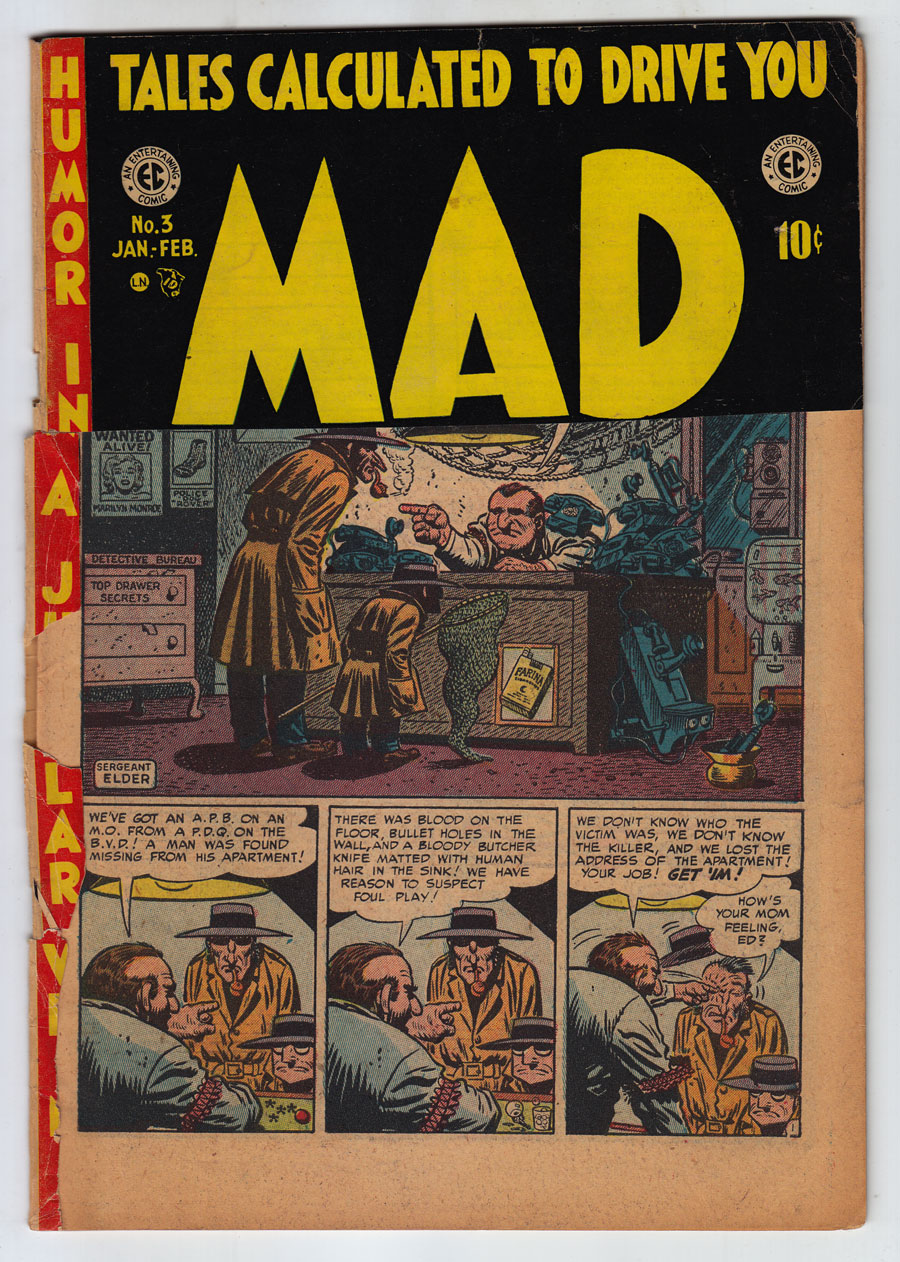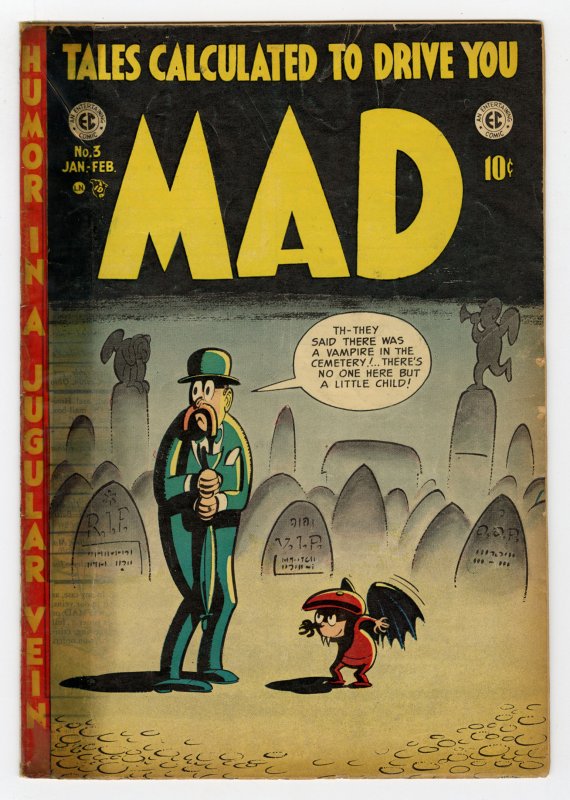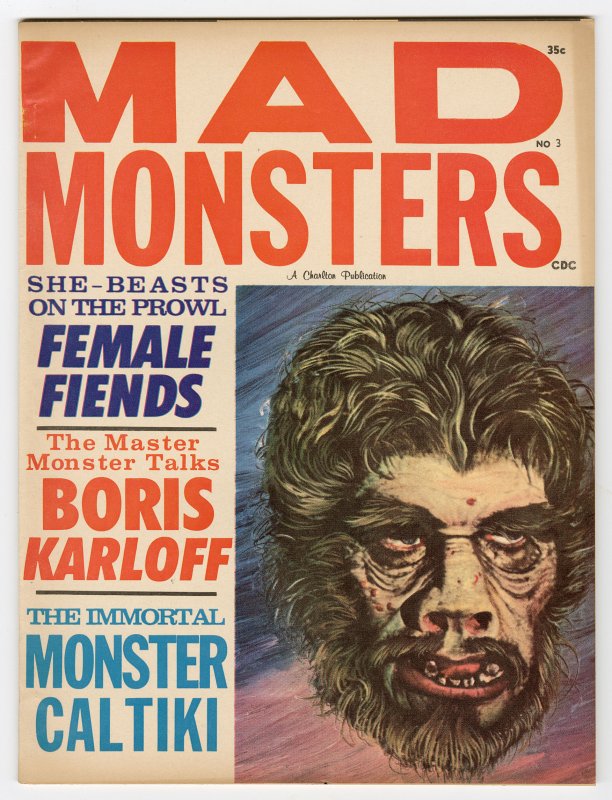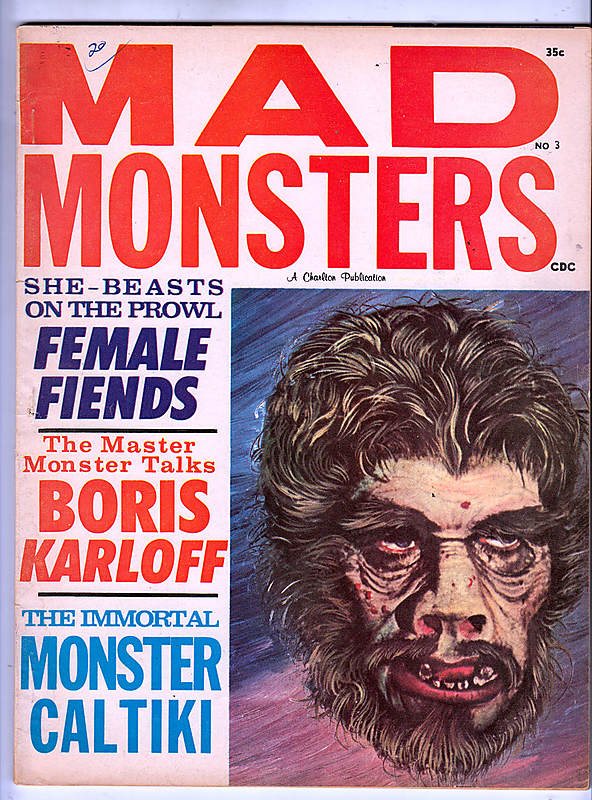MAD (1952-2018) #3
FA: 1.0

(Stock Image)

YES
Accepting Offers
--
Offers
PUBLISHER: EC
COMMENTS: 2/3rd of front cover missing, otherwise complete; ow pgs
Kurtzman vampire cover; Wood, Davis art; Lone Ranger parody
Read Description ▼
Kurtzman vampire cover; Wood, Davis art; Lone Ranger parody
DESCRIPTION
2/3rd of front cover missing, otherwise complete; ow pgs
Kurtzman vampire cover; Wood, Davis art; Lone Ranger parodyTo American kids reading MAD was a rite of passage while growing up from the 1950s to the modern-day, almost every preteen had a stack of MADs lying around their bedroom or rec room, and the influence of the comics/magazines would reverberate throughout their lives. Maybe some would not fully understand everything they read at first, being drawn to the simpler attractions like Don Martin, Spy Vs. Spy or Sergio Aragones’ mini toons in the corners of the pages, but from the very start MAD began laying the groundwork to make young minds think for themselves. By skewering the popular culture kids were absorbing daily, MAD’s writers and artists were educating readers about the absurdity and banality of everyday life, and the entertainment they were being spoon-fed. Whether readers knew it or not, they were being taught to think independently, and as MAD slowly started working on more serious subject matter, their fans grew up with the book, and it is as much of a historical record as any other long-running publication, just with more laughs. Each issue of MAD has something interesting or enriching to experience, and the early days, where the publishers were just starting to establish their footing are some of the most interesting issues in the run. #3 shows the title reaching beyond comics for inspiration, aiming their sights toward the Lone Ranger, Dragnet, and V-V-Vampires!
Artists Information
Will Elder is an American Cartoonist and comic book artist who was part of the team that made up Harvey studios. Will's art style described as wacky panels with humorous details on top of humor. Elder's most notable works include Mad, Little Annie Fanny and Humbug.
Wally Wood is an American comic book artist/ writer who is also one of the founding artist for Mad comics. In addition to penciling numerous comic book pages, Wally also ventured into product illustration, music album covers, and trading cards. Wally's most notable works include the aforementioned Mad comics, Marvel's Daredevil, and Weird-Science Fantasy for EC comics.
Harvey Kurtzman was an American cartoonist and editor. His best-known work includes writing and editing the parodic comic book Mad from 1952 until 1956, and illustrating the Little Annie Fanny strips in Playboy from 1962 until 1988.
John Burton Davis, Jr. was an American cartoonist and illustrator, known for his advertising art, magazine covers, film posters, record album art and numerous comic book stories. He was one of the founding cartoonists for Mad in 1952.
John Powers Severin was an American comics artist noted for his distinctive work with EC Comics, primarily on the war comics Two-Fisted Tales and Frontline Combat; for Marvel Comics, especially its war and Western comics; and for his 45-year stint with the satiric magazine Cracked. He was one of the founding cartoonists of Mad in 1952. Severin was inducted into the Will Eisner Award Hall of Fame in 2003.
Kurtzman vampire cover; Wood, Davis art; Lone Ranger parodyTo American kids reading MAD was a rite of passage while growing up from the 1950s to the modern-day, almost every preteen had a stack of MADs lying around their bedroom or rec room, and the influence of the comics/magazines would reverberate throughout their lives. Maybe some would not fully understand everything they read at first, being drawn to the simpler attractions like Don Martin, Spy Vs. Spy or Sergio Aragones’ mini toons in the corners of the pages, but from the very start MAD began laying the groundwork to make young minds think for themselves. By skewering the popular culture kids were absorbing daily, MAD’s writers and artists were educating readers about the absurdity and banality of everyday life, and the entertainment they were being spoon-fed. Whether readers knew it or not, they were being taught to think independently, and as MAD slowly started working on more serious subject matter, their fans grew up with the book, and it is as much of a historical record as any other long-running publication, just with more laughs. Each issue of MAD has something interesting or enriching to experience, and the early days, where the publishers were just starting to establish their footing are some of the most interesting issues in the run. #3 shows the title reaching beyond comics for inspiration, aiming their sights toward the Lone Ranger, Dragnet, and V-V-Vampires!
Artists Information
Will Elder is an American Cartoonist and comic book artist who was part of the team that made up Harvey studios. Will's art style described as wacky panels with humorous details on top of humor. Elder's most notable works include Mad, Little Annie Fanny and Humbug.
Wally Wood is an American comic book artist/ writer who is also one of the founding artist for Mad comics. In addition to penciling numerous comic book pages, Wally also ventured into product illustration, music album covers, and trading cards. Wally's most notable works include the aforementioned Mad comics, Marvel's Daredevil, and Weird-Science Fantasy for EC comics.
Harvey Kurtzman was an American cartoonist and editor. His best-known work includes writing and editing the parodic comic book Mad from 1952 until 1956, and illustrating the Little Annie Fanny strips in Playboy from 1962 until 1988.
John Burton Davis, Jr. was an American cartoonist and illustrator, known for his advertising art, magazine covers, film posters, record album art and numerous comic book stories. He was one of the founding cartoonists for Mad in 1952.
John Powers Severin was an American comics artist noted for his distinctive work with EC Comics, primarily on the war comics Two-Fisted Tales and Frontline Combat; for Marvel Comics, especially its war and Western comics; and for his 45-year stint with the satiric magazine Cracked. He was one of the founding cartoonists of Mad in 1952. Severin was inducted into the Will Eisner Award Hall of Fame in 2003.


MAD (1952-2018) #3
EC G-: 1.8
ow pages; spine taped
Kurtzman vampire cover; Wood, Davis art; Lone Ranger parody
Kurtzman vampire cover; Wood, Davis art; Lone Ranger parody
ow pages; spine taped
Kurtzman vampire cover; Wood, Davis art; Lone Ranger parody
Kurtzman vampire cover; Wood, Davis art; Lone Ranger parody




